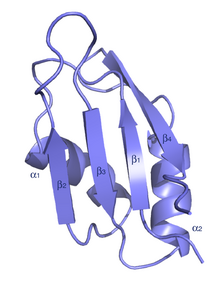RNA認識モチーフ

| RNA recognition motif. (a.k.a. RRM, RBD, or RNP domain) | |||||||||||
|---|---|---|---|---|---|---|---|---|---|---|---|
| 識別子 | |||||||||||
| 略号 | RRM_1 | ||||||||||
| Pfam | PF00076 | ||||||||||
| Pfam clan | RRM CL0221 RRM | ||||||||||
| InterPro | IPR000504 | ||||||||||
| PROSITE | PDOC00030 | ||||||||||
| SCOP | 1sxl | ||||||||||
| SUPERFAMILY | 1sxl | ||||||||||
| |||||||||||
RNA認識モチーフ(RNAにんしきモチーフ、英: RNA recognition motif、略称: RRM)は約90アミノ酸からなるRNA結合ドメインであり、一本鎖RNAを結合することが知られている。多くの真核生物タンパク質に存在する[1][2][3]。
真核生物のRRMファミリーは一本鎖RNA結合タンパク質の中で最大のグループであり、8アミノ酸からなるRNP-1コンセンサス配列が含まれている[4][5]。
RRMタンパク質はさまざまなRNA結合特性と機能を持ち、hnRNP、選択的スプライシングの調節に関与するタンパク質(SR、U2AF2、Sxl)、snRNP(U1、U2)、RNAの安定性や翻訳を調節するタンパク質(PABP、La、Hu)などが含まれる[2][3][5][6]。ヘテロ二量体型スプライシング因子U2AFは2つのRRM様ドメインを持つが、これらはタンパク質認識に特化した機能を持つようである[7]。このモチーフはいくつかの一本鎖DNA結合タンパク質にもみられる。
典型的なRRMは、4本の逆平行βストランドと2本のαヘリックスからなるβ-α-β-β-α-βフォールドをとり、その側鎖がRNAの塩基とスタッキングする。一部のRRMではRNA結合時に3つめのヘリックスが形成される[8]。RRMに関する総説はいくつか発表されている[9][10]。
出典
[編集]- ^ “Heterogeneous nuclear ribonucleoprotein particles and the pathway of mRNA formation”. Trends Biochem. Sci. 13 (3): 86–91. (1988). doi:10.1016/0968-0004(88)90046-1. PMID 3072706.
- ^ a b “Genomic structure and amino acid sequence domains of the human La autoantigen”. J. Biol. Chem. 263 (34): 18043–51. (1988). doi:10.1016/S0021-9258(19)81321-2. PMID 3192525.
- ^ a b “A single domain of yeast poly(A)-binding protein is necessary and sufficient for RNA binding and cell viability”. Mol. Cell. Biol. 7 (9): 3268–76. (1987). doi:10.1128/mcb.7.9.3268. PMC 367964. PMID 3313012.
- ^ “RNA-binding proteins as developmental regulators”. Genes Dev. 3 (4): 431–437. (1989). doi:10.1101/gad.3.4.431. PMID 2470643.
- ^ a b “A common RNA recognition motif identified within a defined U1 RNA binding domain of the 70K U1 snRNP protein”. Cell 57 (1): 89–101. (1989). doi:10.1016/0092-8674(89)90175-X. PMID 2467746.
- ^ “Structural basis for recognition and sequestration of UUU(OH) 3' temini of nascent RNA polymerase III transcripts by La, a rheumatic disease autoantigen”. Mol. Cell 21 (1): 75–85. (2006). doi:10.1016/j.molcel.2005.10.027. PMC 4689297. PMID 16387655.
- ^ “U2AF homology motifs: protein recognition in the RRM world”. Genes Dev. 18 (13): 1513–1526. (2004). doi:10.1101/gad.1206204. PMC 2043112. PMID 15231733.
- ^ “Analysis of the RNA-recognition motif and RS and RGG domains: conservation in metazoan pre-mRNA splicing factors”. Nucleic Acids Res. 21 (25): 5803–5816. (1993). doi:10.1093/nar/21.25.5803. PMC 310458. PMID 8290338.
- ^ “RNA recognition: towards identifying determinants of specificity”. Trends Biochem. Sci. 16 (6): 214–20. (1991). doi:10.1016/0968-0004(91)90088-d. PMID 1716386.
- ^ “The RNA recognition motif, a plastic RNA-binding platform to regulate post-transcriptional gene expression”. FEBS J 272 (9): 2118–31. (2005). doi:10.1111/j.1742-4658.2005.04653.x. PMID 15853797.
